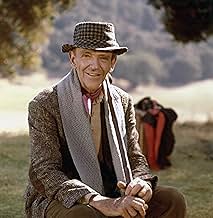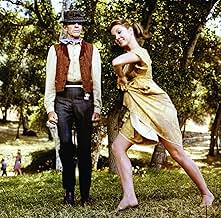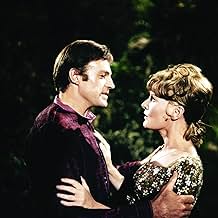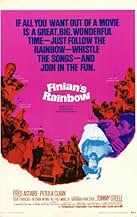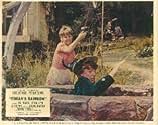IMDb रेटिंग
6.1/10
4.4 हज़ार
आपकी रेटिंग
अपनी भाषा में प्लॉट जोड़ेंAn Irish immigrant and his daughter move into a town in the American South with a magical piece of gold that will change people's lives, including a struggling farmer and African American ci... सभी पढ़ेंAn Irish immigrant and his daughter move into a town in the American South with a magical piece of gold that will change people's lives, including a struggling farmer and African American citizens threatened by a bigoted politician.An Irish immigrant and his daughter move into a town in the American South with a magical piece of gold that will change people's lives, including a struggling farmer and African American citizens threatened by a bigoted politician.
- 2 ऑस्कर के लिए नामांकित
- 1 जीत और कुल 9 नामांकन
Brenda Arnau
- Sharecropper 'Necessity'
- (बिना क्रेडिट के)
Charles Carter
- Sharecropper
- (बिना क्रेडिट के)
Sterling Clark
- Sharecropper
- (बिना क्रेडिट के)
Robert Cleaves
- Geologist
- (बिना क्रेडिट के)
Robert Cole
- Sharecropper
- (बिना क्रेडिट के)
Willie Covan
- Sharecropper
- (बिना क्रेडिट के)
Evelyn Dutton
- Sharecropper
- (बिना क्रेडिट के)
फ़ीचर्ड समीक्षाएं
"Finian's Rainbow" (1968) is one of the few films I saw three times in the theater, and since repeat viewings are normally not my thing it must have made some connection or maybe I just enjoyed watching Barbara Hancock dance. Despite this I agree with most of the critical comments about portions of the film.
Unfortunately it was assembled as a 145 minute "roadshow" musical; these were overlong spectaculars which depended less on the charm of the performers (think 1930's) than on pre-sold event marketing (unnecessary, pretentious, overscale, and distracting production values; souvenir programs; etc.). Right around the time of its release these mega-productions were leading many of the studios to financial ruin. Warner Brothers took a hit from this one; box office was bad but fortunately Coppola worked cheap and had cranked this out on the back-lot with a relatively modest budget.
Trim about 30 minutes from the film and you would have a much better production. There is a lot of stuff here that is supposed to be fun and just doesn't make it. Fortunately there are some real gems sandwiched throughout the film.
Think bi-racial "Lil Abner" (1959) with a touch of "The Wizard of Oz" (1939). The Oz connection comes from lyricist E. Y. Harburg, the guy who gave us "If I Were the King of the Forest". There are enough such silly songs to make up for toughing out the musical clunker moments. Tommy Steele absolutely shines doing this material (insert Bert Lahr here) .
Nothing wrong with the performances of Fred Astaire or Petula Clark either. And its not just his dancing and her singing, they both achieve excellent characterizations. Astaire at 70 does not look much different facially than Astaire at 30. But this time instead of a physically unlikely love interest he plays a warm old man still chasing a dream, and it's a much better fit. Clark does an excellent Debbie Reynolds and more than holds her own through the production.
Unfortunately there is little good to say about the casting of Don Francks as Petula's love interest and Hancock's older brother. Most likely Coppola felt that the film needed a relatively hip looking guy in place of a Gordon MacRae type. But Francks comes off as more of an oily hotshot; the kind of guy who would proposition your 14 year-old sister.
The plot has Finian and his daughter coming to Kentucky to bury a crock of gold he has stolen from a leprechaun back in Ireland. Finian believes that he can produce some kind of synergy by getting the gold within close range of Ft. Knox. They end up in a racially mixed Dogpatch named Rainbow Valley, where blacks and whites work side-by-side as tobacco sharecroppers. There is considerable intrigue involving the local racist political hacks, a new strain of mentholated tobacco being developed by a George Washington Carver type (nicely played by Al Freeman Jr.), back taxes on the sharecropping collective, romance, and a leprechaun who is slowly becoming human.
Barbara Hancock, a young but quite accomplished ballet dancer, is fetching as "Susan the Silent" (who dances instead of talking). Coppola adds a lot of nice lyrical moments by showcasing her dancing. It is said that Astaire resented her being cast instead of an older dancer he recommended. They are not paired in any number, a failure conspicuous by its absence.
The widescreen DVD looks great and the Coppola commentary is surprisingly interesting.
Then again, what do I know? I'm only a child.
Unfortunately it was assembled as a 145 minute "roadshow" musical; these were overlong spectaculars which depended less on the charm of the performers (think 1930's) than on pre-sold event marketing (unnecessary, pretentious, overscale, and distracting production values; souvenir programs; etc.). Right around the time of its release these mega-productions were leading many of the studios to financial ruin. Warner Brothers took a hit from this one; box office was bad but fortunately Coppola worked cheap and had cranked this out on the back-lot with a relatively modest budget.
Trim about 30 minutes from the film and you would have a much better production. There is a lot of stuff here that is supposed to be fun and just doesn't make it. Fortunately there are some real gems sandwiched throughout the film.
Think bi-racial "Lil Abner" (1959) with a touch of "The Wizard of Oz" (1939). The Oz connection comes from lyricist E. Y. Harburg, the guy who gave us "If I Were the King of the Forest". There are enough such silly songs to make up for toughing out the musical clunker moments. Tommy Steele absolutely shines doing this material (insert Bert Lahr here) .
Nothing wrong with the performances of Fred Astaire or Petula Clark either. And its not just his dancing and her singing, they both achieve excellent characterizations. Astaire at 70 does not look much different facially than Astaire at 30. But this time instead of a physically unlikely love interest he plays a warm old man still chasing a dream, and it's a much better fit. Clark does an excellent Debbie Reynolds and more than holds her own through the production.
Unfortunately there is little good to say about the casting of Don Francks as Petula's love interest and Hancock's older brother. Most likely Coppola felt that the film needed a relatively hip looking guy in place of a Gordon MacRae type. But Francks comes off as more of an oily hotshot; the kind of guy who would proposition your 14 year-old sister.
The plot has Finian and his daughter coming to Kentucky to bury a crock of gold he has stolen from a leprechaun back in Ireland. Finian believes that he can produce some kind of synergy by getting the gold within close range of Ft. Knox. They end up in a racially mixed Dogpatch named Rainbow Valley, where blacks and whites work side-by-side as tobacco sharecroppers. There is considerable intrigue involving the local racist political hacks, a new strain of mentholated tobacco being developed by a George Washington Carver type (nicely played by Al Freeman Jr.), back taxes on the sharecropping collective, romance, and a leprechaun who is slowly becoming human.
Barbara Hancock, a young but quite accomplished ballet dancer, is fetching as "Susan the Silent" (who dances instead of talking). Coppola adds a lot of nice lyrical moments by showcasing her dancing. It is said that Astaire resented her being cast instead of an older dancer he recommended. They are not paired in any number, a failure conspicuous by its absence.
The widescreen DVD looks great and the Coppola commentary is surprisingly interesting.
Then again, what do I know? I'm only a child.
First, FINIAN'S RAINBOW does not take place in Tennessee. The movie only mentions Rainbow Valley, but onstage the valley is in Missitucky, home to Fort Knox and the gold depository that was thankfully saved by James Bond in later (for the movie, earlier) years.
The movie's flaws lie not so much in the updating to 1968 as in the eyes of today's viewers. We have sadly grown used to movies that are paced much faster than this one. As a result, those too young to have grown up with older movies will consider FINIAN'S RAINBOW very slow and overlong.
Fundamentally, though, FINIAN'S RAINBOW suffers the same afflictions all stage musicals suffer when transcribed to the big screen: Loss of intimacy. Hollywood always makes stage musicals 'way too big. They think musicals have to take place all over the continent. Oddly, a single stage worked for the play, and still does. (Possibly the rare exception to this is THE MUSIC MAN which was "opened up" only enough, not too much.) All movies are of their times, especially movie musicals. Accept that and enjoy FINIAN'S RAINBOW's wonderful score and excellent performances by the entire cast.
The movie's flaws lie not so much in the updating to 1968 as in the eyes of today's viewers. We have sadly grown used to movies that are paced much faster than this one. As a result, those too young to have grown up with older movies will consider FINIAN'S RAINBOW very slow and overlong.
Fundamentally, though, FINIAN'S RAINBOW suffers the same afflictions all stage musicals suffer when transcribed to the big screen: Loss of intimacy. Hollywood always makes stage musicals 'way too big. They think musicals have to take place all over the continent. Oddly, a single stage worked for the play, and still does. (Possibly the rare exception to this is THE MUSIC MAN which was "opened up" only enough, not too much.) All movies are of their times, especially movie musicals. Accept that and enjoy FINIAN'S RAINBOW's wonderful score and excellent performances by the entire cast.
I first saw this movie as a young girl and developed an instant crush on Tommy Steele. The storyline is very entertaining with a keen sense of humor. It was also great seeing Fred Astaire again - I'm a big fan. This movie has some of the most memorable songs which are still among my favorites, of course many of them featuring Petula Clarke. If you are a fan of musicals and enjoy a bit of the blarney - then this movie will be right up your ally.
I remember seeing this film when it was first released. I absolutely hated it - too slow-moving, and the male romantic lead was a cipher. Even the songs were manipulated to the point that I could barely stand to listen to them. Tommy Steele was far too frenetic as Og, the leprechaun. Its saving graces were Fred Astaire, Petula Clark (although she seemed too old in the role of Sharon), and Keenan Wynn. I've avoided it like the plague ever since.
Tonight, thanks to Turner Classic Movies, I finally watched it again. And you know what? It's a lot better than I remembered. I don't know what has caused the turnabout in my opinion, except perhaps the lack of quality of most of the musical films that have come along since FINIAN'S RAINBOW in 1968. It still has a few longueurs, but generally it's very enjoyable. Even Tommy Steele isn't too bad. Don Francks is still dramatically stiff, but he's better than I remembered, and he sings well. And oh, those songs! It's a shame that "Necessity" was cut, but otherwise, what a string of melody - How are Things in Glocca Morra, Old Devil Moon, When I'm not Near the Girl I Love, and more.
Thank you, TCM, for giving me a second chance with this film!
Tonight, thanks to Turner Classic Movies, I finally watched it again. And you know what? It's a lot better than I remembered. I don't know what has caused the turnabout in my opinion, except perhaps the lack of quality of most of the musical films that have come along since FINIAN'S RAINBOW in 1968. It still has a few longueurs, but generally it's very enjoyable. Even Tommy Steele isn't too bad. Don Francks is still dramatically stiff, but he's better than I remembered, and he sings well. And oh, those songs! It's a shame that "Necessity" was cut, but otherwise, what a string of melody - How are Things in Glocca Morra, Old Devil Moon, When I'm not Near the Girl I Love, and more.
Thank you, TCM, for giving me a second chance with this film!
I love musicals and have done for the longest time. Finian's Rainbow is not among the best of the film musicals, but it is hardly among the worst either. It does have a ridiculous story and some moments of awkward editing. That said, it is definitely worth watching and is for me Francis Ford-Coppola's most underrated film.
The editing aside, I like the production values a lot, as the sets and costumes are lovely and there is some good lighting. The score and songs are all wonderful, my least favourite The Begat is still very good, and Old Devil Moon, When the Idle Poor Became the Idle Rich and particularly Look to the Rainbow are timeless.
Coppola directs with assurance, the choreography is some of the best I've seen in a while and the script has a lot of funny, witty and heart warming parts. When it comes to favourite scenes, the Rain Dance Ballet, which is lovingly choreographed, and the scene where Al Freeman Jnr applies for the job of butler, which is hilarious, are the most memorable to me.
I can't fault the cast either, Fred Astaire can do no wrong in my eyes, Tommy Steele and Al Freeman Jnr steal every scene they're in and I don't think there is another film where Petula Clark is more perfectly cast. In conclusion, flawed but definitely worth the watch. 8/10 Bethany Cox
The editing aside, I like the production values a lot, as the sets and costumes are lovely and there is some good lighting. The score and songs are all wonderful, my least favourite The Begat is still very good, and Old Devil Moon, When the Idle Poor Became the Idle Rich and particularly Look to the Rainbow are timeless.
Coppola directs with assurance, the choreography is some of the best I've seen in a while and the script has a lot of funny, witty and heart warming parts. When it comes to favourite scenes, the Rain Dance Ballet, which is lovingly choreographed, and the scene where Al Freeman Jnr applies for the job of butler, which is hilarious, are the most memorable to me.
I can't fault the cast either, Fred Astaire can do no wrong in my eyes, Tommy Steele and Al Freeman Jnr steal every scene they're in and I don't think there is another film where Petula Clark is more perfectly cast. In conclusion, flawed but definitely worth the watch. 8/10 Bethany Cox
क्या आपको पता है
- ट्रिवियाMany, including Fred Astaire, blamed director Francis Ford Coppola for cutting off Astaire's feet during filming of his dancing scenes, but it was Warner Bros. who decided, after the filming had been completed in 35mm, to convert the film to the wider 70mm and promote it as a "reserved-ticket roadshow attraction." This was achieved by cropping off the tops and bottoms of the film frame, including some shots of Astaire's footwork.
- गूफ़In the song "Old Devil Moon" as Woody and Sharon dance through the stream, Woody has bare feet and his hands are in Sharon's. In the next shot, he has his shoes on, and it even looks as if his trousers are dry.
- इसके अलावा अन्य वर्जनFilmed in 35mm, Warners decided afterwards to promote it as a "reserved-ticket roadshow attraction" and converted it to 70mm, creating a wider-screen aspect ratio by cropping away the tops and bottoms of the images, and cropping away Fred Astaire's feet during some of his dance scenes. Restored versions show the original aspect ratio.
- कनेक्शनEdited into The Kid Stays in the Picture (2002)
- साउंडट्रैकLook To The Rainbow / How Are Things In Glocca Morra?
(1946) (uncredited)
(Main Title)
Played during the opening credits
Lyrics by E.Y. Harburg
Music by Burton Lane
Sung by Petula Clark ("Rainbow") and played by the Warner Bros.
Orchestra ("Glocca Morra") conducted by Ray Heindorf
टॉप पसंद
रेटिंग देने के लिए साइन-इन करें और वैयक्तिकृत सुझावों के लिए वॉचलिस्ट करें
- How long is Finian's Rainbow?Alexa द्वारा संचालित
विवरण
बॉक्स ऑफ़िस
- बजट
- $35,00,000(अनुमानित)
- चलने की अवधि2 घंटे 21 मिनट
- पक्ष अनुपात
- 2.39 : 1
इस पेज में योगदान दें
किसी बदलाव का सुझाव दें या अनुपलब्ध कॉन्टेंट जोड़ें



